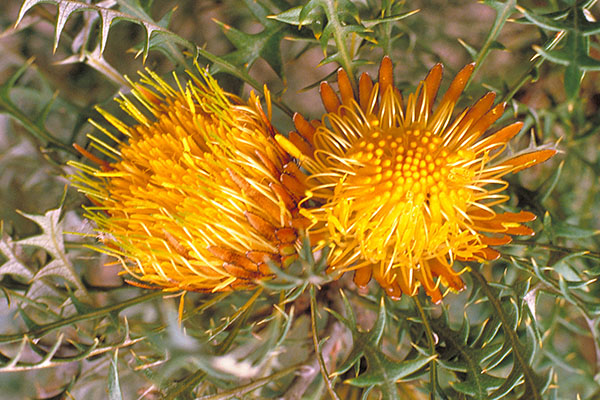General Description:
Banksia is a large genus of over 200 species in the Protea family, having been increased in size through the transfer of species in the former genus Dryandra to Banksia (see footnote box). The genus is almost exclusively Australian, being found in all States and Territories. A single species (B.dentata) is found in islands to Australia’s north as well as in tropical Australia.
Banksia borealis has been in cultivation among enthusiasts for some time but it has only recently been formally named. There are two recognised subspecies; subsp.borealis occurs in the Kalbarri area about 400 km north of Perth while subsp.elatior occurs about 200 km further south in a restricted area near Three Springs. The former subspecies differs from subsp.elatior in being a smaller plant overall and having leaves which have a distinct twist. B.borealis subsp.elatior is regarded as being endangered.
The typical form is a small shrub to about 1 metre in both height and width. The leaves are around 90 mm long by 30 mm wide but deeply lobed almost to the mid-rib. As indicated above, a distinctive feature is the spiral twisting (between 1 and 3 times) along the length of the leaves. B.borealis subsp. elatior is a larger plant reaching 2.5 metres in height.
The flowers clusters of B.borealis are bright orange-yellow and around 30-35 mm in diameter. They are conspicuously displayed either at the ends of stems or in the leaf axils and are seen in late winter through to late spring.
B.borealis is not well known in cultivation but is a very desirable plant which has proven itself to be hardier than many other in the former genus Dryandra in sub-tropical areas. It has been flowered successfully in Sydney in a well drained sunny position.
Propagation from seed is relatively easy and cuttings may be successful but slow to strike.
A paper published in 2007 proposed that the genus Dryandra be subsumed into Banksia. This revised classification has been accepted by the Council of Heads of Australasian Herbaria and the new Banksia names now appear on Florabase (the website for the Western Australian Herbarium) and in the Australian Plant Census.
The new classification has come in for some criticism but, as the Austraian Plant Census has been adopted as the authority on plant names by ANPSA, the revised classication has been accepted on the ANPSA website. The previous Dryandra names will also be mentioned where appropriate. For further information refer to our Banksia page.

Banksia borealis (syn. Dryandra borealis)
Photo: Brian Walters
Images of all species in the former genus Dryandra can be seen in the Dryandra Study Group’s Dryandra Image Gallery
 Australian Native Plants Society (Australia)
Australian Native Plants Society (Australia)